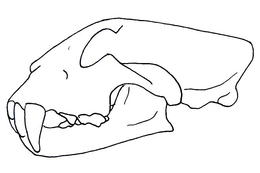Dinofelis
| Dinofelis Temporal range: Pliocene–Pleistocene, 5–1.2Ma | |
|---|---|
| Scientific classification | |
| Kingdom: | Animalia |
| Phylum: | Chordata |
| Class: | Mammalia |
| Order: | Carnivora |
| Family: | Felidae |
| Tribe: | †Metailurini |
| Genus: | †Dinofelis Zdansky, 1924 |
| Species | |
|
†Dinofelis aronoki | |
Dinofelis is a genus of sabre-toothed cats (Felinae) belonging to the tribe Metailurini. They were widespread in Europe, Asia, Africa and North America at least 5 million to about 1.2 million years ago (Early Pliocene to Early Pleistocene). Fossils very similar to Dinofelis from Lothagam range back to the Late Miocene, some 8 million years ago.
Description and ecology

In size they were between a modern leopard and a lion, most being about the size of a jaguar (70 cm tall and up to 120 kg), medium-sized but powerful cats that possessed two prominent sabre teeth. The front limbs were particularly robust compared to the modern cats (even the jaguar). This stout body may implicate a preference for dense or mixed habitats although it may also have been similar to the extant jaguar with its range from forest to open range including wetland.
Body mass
Two specimens were examined by Serge Legendre and Claudia Roth for body mass. The first specimen was estimated to have a weight of 31.4 kg (69 lb). The second was estimated to have a weight of 87.8 kg (190 lb).[1]
Dentition
The canine teeth of Dinofelis are longer and more flattened than those of modern cats but less so than those of true saber-tooths. Dinofelis and Nimravids are generally referred to as "false saber-tooth" cats because of this. (However, Nimravids are not close relatives of Dinofelis.) While the lower canines are robust, the cheek teeth are not nearly as robust as those of the lion and other modern big cats.[2]
Fossils
Dinofelis fossils and bones have been found in South Africa along with those of the baboons that it possibly killed. Bones from several specimens of Dinofelis and baboons were found in a natural trap. Dinofelis may have entered the place to feed on trapped animals or may have simply wandered into a location and was not able to escape again. Several fossils sites from South Africa seem to show that Dinofelis may have hunted and killed Australopithecus africanus since they harbored fossilized remains of Dinofelis, hominids, and other large contemporary animals of the period. Also, since Dinofelis remains have been found near Paranthropus fossil skulls in South Africa, a few of which have peculiar twin holes in their crania matching the Dinofelis upper canines's spacing almost exactly, it is possible that Dinofelis was preying on robust hominids as well.
It is thought that the gradual disappearance of the forests in which Dinofelis hunted may have contributed to its extinction at the start of the ice age.
Diet
Dinofelis hunted animals including, mammoth calves, young and old mastodons, Homo habilis (an ancestor of modern humans) and other animals.
Species
Other undescribed species may exist.[3]
- Dinofelis aronoki: It lived in Villafranchian and Biharian stage in Kenya and Ethiopia. Recently split from D. barlowi.
- Dinofelis barlowi: It lived from the Early Pliocene to the late Pleistocene. Geographically, found in Europe, North America and Asia but mainly in Africa and the range had a widespread. It was 70 cm high and 1 m long, probably the smallest or a medium species of Dinofelis but it was still a powerful good hunter.
- Dinofelis cristata: It was found in China. (Includes D. abeli.)
- Dinofelis darti: It lived in South Africa during the Villafranchian stage.
- Dinofelis diastemata: Europe
- Dinofelis paleoonca: North America
- Dinofelis petteri: East Africa
- Dinofelis piveteaui: South Africa
- Dinofelis sp. "Langebaanweg"
- Dinofelis sp. "Lothagam"
In popular culture
Dinofelis appears in the BBC documentary, Walking with Beasts, as a predator of Australopithecus.
In the opening scene of 2001: A Space Odyssey a group of primitive hominids, prior to their discovery of tools, live in fear of a large predatory cat (portrayed by an actual jaguar) which likely would have been a Dinofelis, although in Arthur C. Clarke's novel, the cat is referred to throughout as a "leopard".
Footnotes
- ↑ Legendre, Serge & Roth, Claudia (1988), "Correlation of carnassial tooth size and body weight in recent carnivores (Mammalia)", Historical Biology 1 (1): 85–98, doi:10.1080/08912968809386468
- ↑ Turner 1997, pp. 41–43.
- ↑ Werdelin & Lewis 2001, .
References
- Haines, Tom & Chambers, Paul (2006), The Complete Guide to Prehistoric Life, Canada: Firefly Books, p. 181
- Turner, Alan (1997), The Big Cats and their fossil relatives, New York: Columbia University Press, ISBN 0-231-10228-3
- Werdelin, Lars & Lewis, Margaret E. (2001), "A revision of the genus Dinofelis (Mammalia, Felidae)", Zoological Journal of the Linnean Society 132 (2): 147–258, doi:10.1006/zjls.2000.0260